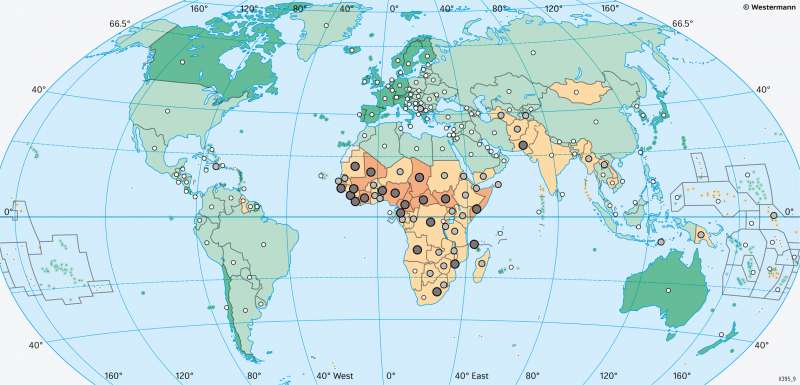The World - Life expectancy
Level of development
978-3-14-100890-6 | Page 35 | Ill. 3

Overview
Technological and scientific achievements over the past centuries and decades have had a major impact on human lifespan. Currently, life expectancy in the Western world is in the range of about 80 years. It should be noted that there are differences between the sexes. In most cases, the life expectancy of women exceeds that of men.
Life expectancy - sub-indicator of the HDI
Life expectancy at birth, shown here with area colours, is a sub-indicator of the Human Development Index (HDI, see map 34.1). Statements on infant mortality can be made on the basis of the dot signatures.
Global differences in life expectancy and their causes
The map shows the great differences in development between the countries of the world. Areas with above-average life expectancy are North and South America (with only a few exceptions such as Haiti and Guyana), Europe (with the exception of Kosovo), Australia and Oceania, North Africa, most states in East and Southeast Asia and most states in West Asia.
While life expectancy has increased in large parts of the world, it has been declining in many states in the territory of the former Soviet Union since the late 1980s and is currently at a similar level there as in the early 1970s. Sub-Saharan Africa has both below-average life expectancy and high infant mortality. Outside Africa, only Afghanistan has similarly poor values.
Many countries in South and Central Asia, including India and Pakistan, have below-average life expectancy and often high infant mortality. As in Africa, this is an indicator of fundamental development problems that affect broad sections of the population.
The use of further indicators for health development
An incomplete health care system, poor hygienic conditions, contaminated drinking water or quantitative or qualitative malnutrition favour the spread of diseases and cause mortality to skyrocket. The fact that in many developing countries only two-thirds of all women are attended to by a doctor, midwife or nurse during childbirth is largely responsible for the sometimes very high infant and maternal mortality rates. Therefore, the two indicators shown in the map are well suited to assess the level of development of the health system, the access to clean drinking water and also the food security of a country.
Global Millennium Development Goals on reducing mortality rates
Two key Millennium Development Goals were to reduce maternal mortality in childbirth and infant mortality. In 1990, 97 out of every 1000 children in developing countries died before reaching the age of five; by 2015, this figure should be two-thirds lower. This has been achieved in some parts of the world, for example in East Asia. Overall, however, the target was clearly missed.




